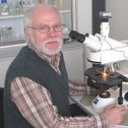Inhibition of inflammatory cytokine production and lymphocyte proliferation by structurally different sesquiterpene lactones correlates with their effect on activation of NF-kappaB.
Ключови думи
Резюме
Many sesquiterpene lactones (Sls) are known to possess anti-inflammatory activities. To gain further insight into their structure-activity relationships and the molecular mechanism of action, four germacranolide sesquiterpene lactones which differ in the skeleton and the number of reactive centers (4beta,15-epoxy-miller-9E-enolide (1), 15-acetoxy-eremantholide B (2), a mixture of 15-(isovaleroyl)/15-(2-methyl-butyryl)-2alpha-acetoxy-miguanin (3), and 15-(2-hydroxy)-isobutyryloxy-micrantholide (4)) were investigated for their effect on production of proinflammatory cytokines (interleukin-1beta [IL-1beta], IL-6, and tumor necrosis factor-alpha [TNF-alpha]) as well as proliferation of concanavalin A (Con A) and lipopolysaccharide (LPS)-stimulated mouse lymphocytes. Compounds 1 and 3 which possess an alpha-methylene-gamma-lactone function and a conjugated carbonyl group induced a half-maximal inhibition of cytokine synthesis in adherent mouse peritoneal exudate cells at micromolar concentrations (IC(50) 0.69-1.70 microM), while compound 4 which contains only an alpha-methylene-gamma-lactone residue was less active (IC(50) > or 38 microM). Interestingly, compound 2, which carries only a conjugated keto group, displayed a potency similar to those of the bifunctional compounds 1 and 3. All four Sls suppressed proliferation of murine lymphocyte at IC(50) concentrations between 0.22 and 5.03 microM. The rank order of potency was 1 = 2 > 3 > 4. Generally, the growth of LPS-stimulated cells was more strongly influenced than those of Con A-activated lymphocytes. This effect was particularly pronounced with 4. Inhibitory concentrations correlated well with those necessary for inhibition of the transcription factor nuclear factor kappaB (NF-kappaB) observed in a previous investigation. Therefore, it can be assumed that NF-kappaB may be involved in the suppressive effect of Sls on cytokine production and lymphocyte proliferation.


